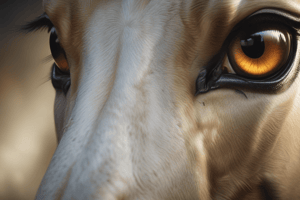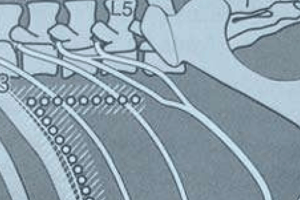Podcast
Questions and Answers
Which of the following is a potential cause of death during the recovery phase of large animal anesthesia?
Which of the following is a potential cause of death during the recovery phase of large animal anesthesia?
- Respiratory obstruction (correct)
- Fractures and recovery
- Post-anesthetic myopathy
- Intraoperative cardiac arrest
What is the recommended approach for reducing risk of laryngeal obstruction during anesthesia?
What is the recommended approach for reducing risk of laryngeal obstruction during anesthesia?
- Use emergency tracheostomy
- Administer sedatives
- Re-intubate the horse
- Select appropriate ET tube size and insert gently (correct)
What is a common complication during the recovery period of equine anesthesia?
What is a common complication during the recovery period of equine anesthesia?
- Acute respiratory distress syndrome
- Epistaxis
- Pulmonary edema
- Nasal oedema (correct)
What is the primary purpose of using nasopharyngeal tubes or phenylephrine during the recovery period?
What is the primary purpose of using nasopharyngeal tubes or phenylephrine during the recovery period?
What is the recommended treatment for pulmonary edema during the recovery phase?
What is the recommended treatment for pulmonary edema during the recovery phase?
What is a potential risk associated with recovering horses with nasopharyngeal tubes?
What is a potential risk associated with recovering horses with nasopharyngeal tubes?
What is the primary reason for using an emergency tracheostomy during anesthesia?
What is the primary reason for using an emergency tracheostomy during anesthesia?
What is the main cause of death during the recovery period of equine anesthesia?
What is the main cause of death during the recovery period of equine anesthesia?
What is the recommended approach for managing nasal oedema during the recovery period?
What is the recommended approach for managing nasal oedema during the recovery period?
Which of the following is a potential problem in recovery after anesthesia in horses?
Which of the following is a potential problem in recovery after anesthesia in horses?
What is one of the causes of post-operative myopathy in horses during the recovery period?
What is one of the causes of post-operative myopathy in horses during the recovery period?
Which of the following is not a potential post-operative neuropathy in horses during recovery?
Which of the following is not a potential post-operative neuropathy in horses during recovery?
What statement is true with regard to the difference between myopathies and neuropathies in horses during recovery?
What statement is true with regard to the difference between myopathies and neuropathies in horses during recovery?
What is a potential problem associated with spinal cord malacia in horses during recovery?
What is a potential problem associated with spinal cord malacia in horses during recovery?
Which species has a higher mortality rate in anesthesia compared to horses?
Which species has a higher mortality rate in anesthesia compared to horses?
What can be done to reduce the risk of post-operative neuropathy in horses during recovery?
What can be done to reduce the risk of post-operative neuropathy in horses during recovery?
Which of the following is a potential problem associated with hypoxemia in horses during recovery?
Which of the following is a potential problem associated with hypoxemia in horses during recovery?
What can significantly increase blood pressure in horses during anesthesia?
What can significantly increase blood pressure in horses during anesthesia?
During the recovery phase, what is the main indicator before removing the endotracheal (ET) tube in horses?
During the recovery phase, what is the main indicator before removing the endotracheal (ET) tube in horses?
What is a potential problem that can arise during the recovery phase of anesthesia in horses?
What is a potential problem that can arise during the recovery phase of anesthesia in horses?
What should be done to prevent horses from recovering too quickly before they've expelled all isoflurane during the recovery process?
What should be done to prevent horses from recovering too quickly before they've expelled all isoflurane during the recovery process?
What should be done to stimulate breathing if the horse is slow to resume normal ventilation after being disconnected from the ventilator?
What should be done to stimulate breathing if the horse is slow to resume normal ventilation after being disconnected from the ventilator?
Which position should the horse be placed in the recovery box after being moved from the table?
Which position should the horse be placed in the recovery box after being moved from the table?
What is a potential cause of upper airway obstruction during the recovery phase of anesthesia in horses?
What is a potential cause of upper airway obstruction during the recovery phase of anesthesia in horses?
What is the purpose of using nasal tubes during the recovery phase of anesthesia in horses?
What is the purpose of using nasal tubes during the recovery phase of anesthesia in horses?
What may not be a potential sign of upper airway obstruction in horses during recovery from anesthesia?
What may not be a potential sign of upper airway obstruction in horses during recovery from anesthesia?
What is the recommended approach for managing laryngeal obstruction during anesthesia in horses?
What is the recommended approach for managing laryngeal obstruction during anesthesia in horses?
Which of the following is a potential problem that can occur during the recovery phase of equine anesthesia?
Which of the following is a potential problem that can occur during the recovery phase of equine anesthesia?
What is a potential complication that can arise during the recovery period in horses?
What is a potential complication that can arise during the recovery period in horses?
Which of the following is a potential cause of post-operative myopathy in horses during recovery?
Which of the following is a potential cause of post-operative myopathy in horses during recovery?
Which of the following is a potential risk factor associated with anesthesia in horses?
Which of the following is a potential risk factor associated with anesthesia in horses?
What is a potential complication that can occur during the recovery phase of equine anesthesia?
What is a potential complication that can occur during the recovery phase of equine anesthesia?
Which of the following is a common potential cause of death during the recovery period of equine anesthesia?
Which of the following is a common potential cause of death during the recovery period of equine anesthesia?
What is a potential problem associated with post-operative neuropathy in horses during recovery?
What is a potential problem associated with post-operative neuropathy in horses during recovery?
What is the difference between myopathies and neuropathies in horses during recovery?
What is the difference between myopathies and neuropathies in horses during recovery?
What is the main cause of death during the recovery phase of large animal anesthesia?
What is the main cause of death during the recovery phase of large animal anesthesia?
What is the recommended approach for managing laryngeal obstruction during anesthesia in horses?
What is the recommended approach for managing laryngeal obstruction during anesthesia in horses?
What is a potential problem associated with recovering horses with nasopharyngeal tubes?
What is a potential problem associated with recovering horses with nasopharyngeal tubes?
Which of the following is a potential post-operative neuropathy in horses during recovery?
Which of the following is a potential post-operative neuropathy in horses during recovery?
What is the primary purpose of using nasopharyngeal tubes or phenylephrine during the recovery period?
What is the primary purpose of using nasopharyngeal tubes or phenylephrine during the recovery period?
What is a common complication during the recovery period of equine anesthesia?
What is a common complication during the recovery period of equine anesthesia?
What is the main purpose of using oxygen during the recovery phase of anesthesia in horses?
What is the main purpose of using oxygen during the recovery phase of anesthesia in horses?
What is the purpose of using sedatives during the recovery process of large animal anesthesia?
What is the purpose of using sedatives during the recovery process of large animal anesthesia?
What should be done to prevent overextension of the neck during the recovery phase of anesthesia in horses?
What should be done to prevent overextension of the neck during the recovery phase of anesthesia in horses?
What position should the horse be placed in the recovery box after being moved from the table?
What position should the horse be placed in the recovery box after being moved from the table?
What is the main indicator before removing the endotracheal (ET) tube during the recovery phase in horses?
What is the main indicator before removing the endotracheal (ET) tube during the recovery phase in horses?
What is a potential problem that can arise during the recovery phase of large animal anesthesia?
What is a potential problem that can arise during the recovery phase of large animal anesthesia?
Which of the following is a potential sign of upper airway obstruction in horses during recovery from anesthesia?
Which of the following is a potential sign of upper airway obstruction in horses during recovery from anesthesia?
What is a potential cause of death during the recovery phase of large animal anesthesia?
What is a potential cause of death during the recovery phase of large animal anesthesia?
What is the purpose of using nasal tubes during the recovery phase of anesthesia in horses?
What is the purpose of using nasal tubes during the recovery phase of anesthesia in horses?
What is a potential risk associated with recovering horses with nasopharyngeal tubes?
What is a potential risk associated with recovering horses with nasopharyngeal tubes?
What can be done to stimulate breathing if the horse is slow to resume normal ventilation after being disconnected from the ventilator?
What can be done to stimulate breathing if the horse is slow to resume normal ventilation after being disconnected from the ventilator?
Flashcards are hidden until you start studying




